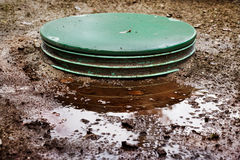 Sewage pumps do all the nasty work for us so we don’t have to deal with all the waste. Most people don’t know much about sewage pumps, seeing as they are below ground and people typically never think twice about where there sewage is heading and how it’s getting there. Of course, as a plumbing company, All Star Plumbing & Restoration knows a thing or two about how sewage systems work and would like to inform you!
Sewage pumps do all the nasty work for us so we don’t have to deal with all the waste. Most people don’t know much about sewage pumps, seeing as they are below ground and people typically never think twice about where there sewage is heading and how it’s getting there. Of course, as a plumbing company, All Star Plumbing & Restoration knows a thing or two about how sewage systems work and would like to inform you!
Most sewage systems use the natural force of gravity to pump waste from one location to another. However, in some cases, sewage systems can’t use gravity because its not possible to place the sewage basin (like a septic tank) below the area where sewage needs to be drained. For example, a basement with a bathroom would often be lower in the ground than where a sewage basin would have to be. In these instances, a sewage pump is needed. Sewage pumps are installed in the lowest point of a sewage basin, which is underground itself. Often submerged completely, pumps work to empty as much liquids and solids as possible from the basin. However, not all of the waste is emptied by a sewage pump, as the pump is slightly higher than the bottom of the basin. The only way to empty a basin completely is to do it manually.
While some sewage pumps have to be manually turned on to drain waste, others have an automatic switch that drains sewage when needed. These automatic switches use bulbs, much like the one you would see in your toilet, to tell the sewage pump to begin to drain. Once sewage in the basin reaches the point of the bulb, it is then switched on and drained accordingly until the it is past a certain height to prevent overflow.
In general, manual switches are not recommended for sewage pumps in basins due to the high risk of an overflow if left unmaintained. In such a case, you would often see dark patches in your yard where your septic tank would be and have an overwhelming smell wafting about your property. If this occurs, call All Star Plumbing & Restoration and we can clean up the mess and take precautions to assure it won’t happen again.
To allow solids to to pass through, sewage pumps are often powered electrically with voltages ranging from 115 to 575. In order to process both liquids and solids, sewage pumps use impellers to cause water pressure to push sewage down the pump and drain. This process is much like the mechanics used by a typical garbage disposal. Household pumps can often handle solids up to 2 inches in diameter, while commercial pumps can handle even larger waste.
In the case that you need a sewage pump installed, you can contact All Star Plumbing & Restoration sewage pump installation and we tend to all of your sewage waste needs! We also install sump pumps, the bulb used in sewage pumps telling it when to drain. If you live in the Boise/Meridian area, we can care for all of your plumbing and restoration needs!





